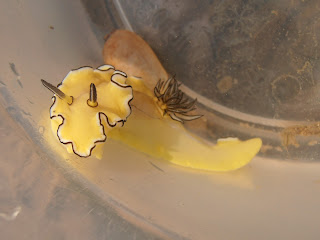I must say that the process of identifying it has been exceedingly fun and stimulating and all the more rewarding as it is so 'alien'. The journey with the mind went much much further than half a world away. Like I always say, the mind is bigger than the universe. I think I have been there and back again.
May we present you Piriqueta racemosa. A beautiful name, isn't it? : ) Enjoy the images below.
 |
| Fruit: 3-valved capsule and pitted curved seeds. Common English name of the herb: Rigid Stripeseed. |
 |
| Opened yellow flowers |
 |
| Hairy calyx |
 |
| Inflorescence |
 |
| Flowers and fruits spirally arranged. |
 |
| Peduncle long and slender. |
 |
| Stem round slender and bristly (hispid). The stiff long hairs is reflected in one of the synonym - Turnera hispidissima. |
 |
| Annual herb about 35 -50cm tall. Leaves sweet smelling when crushed. |
 |
| Leaf upper surface bristly glandular. |
 |
| Leaf underside velvety; margin crenulate. |
 |
| Found in Pulau Ubin, 2012 "Long ago introduced into the Bogor Botanical Gardens, since long naturalized in the region between Djakarta and Bogor." (Van Steenis, 1948) |
References:
Britton and Wilson (1924), p 598; Scientific Survey of Porto Rico and the Virgin Islands; N.Y. Academy of Sciences 5(4).
Van Steenis, C.G.G.J. et al (1948), pp 4:235-236; Flora Malesiana, Series I. Noordhoff-Kolff, Djakarta, 1948-1954, 14 volumes.







































